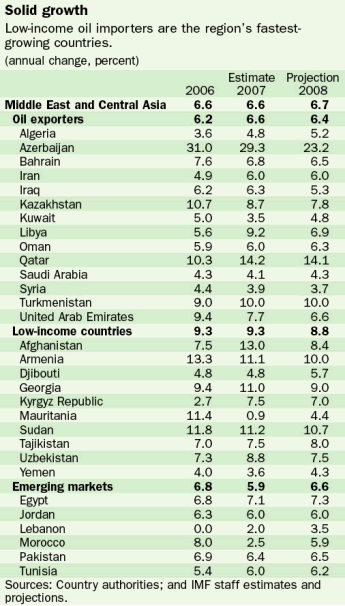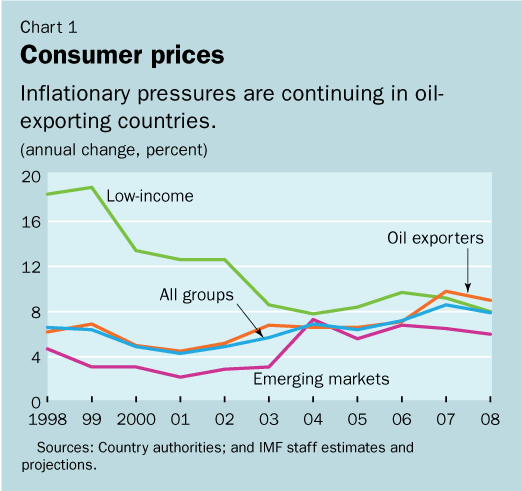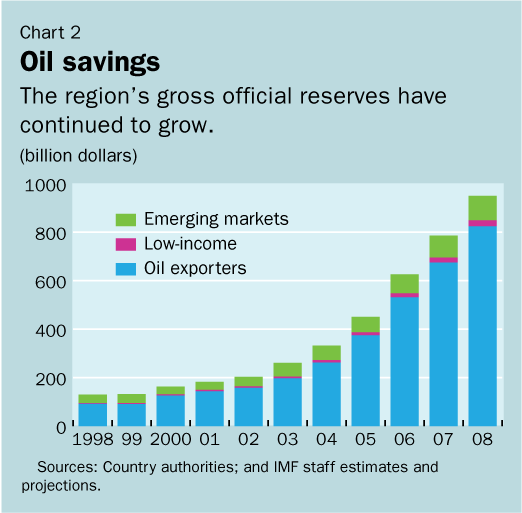
Typical street scene in Santa Ana, El Salvador. (Photo: iStock)
IMF Survey: Middle East, Central Asia: Strong Growth With Inflation Risk
October 30, 2007
- Growth strong across Middle East and Central Asia, but inflation rising in many countries
- Downside risks to the outlook have increased
- Major challenge will be to manage strong foreign exchange inflows
The Middle East and Central Asian region is growing at 6½ percent in 2007, and growth is expected to be about the same in 2008.

Construction in Dubai, UAE: Region becoming more diversified, non-oil sector increasingly important (photo: Jobard/Sipa)
REGIONAL ECONOMIC OUTLOOK
Although the overall outlook is favorable, the downside risks from the global economy have increased, and the region must tackle important policy challenges to sustain strong growth and make further progress in reducing poverty and unemployment.
Growth in the region—which comprises 30 countries divided into oil exporters, low-income countries, and emerging markets—will outstrip global growth in 2007 for the eighth year in a row (see table). Moreover, GDP growth is outpacing population growth. "The message is that the region is booming," said Mohsin S. Khan, Director of the IMF's Middle East and Central Asia Department. "Per capita incomes have more than doubled over the past decade."

In the oil-exporting countries, growth is expected to be about 6½ percent this year and next, underpinned by non-oil activity. The low-income countries are growing the fastest at 9 percent this year, although growth should slow slightly next year. Trailing behind, the emerging market countries are estimated to grow by slightly less than 6 percent in 2007, but should return in 2008 to the 6½-7 percent range they recorded in 2006.
Inflation picking up
Inflation in the region, however, has picked up to about 8½ percent this year and is likely to ease only slightly in 2008 (see Chart 1). The oil-exporting countries will see inflation jump to 10 percent this year from 7 percent last year. Inflation has been low in Bahrain, Kuwait, and Saudi Arabia because these countries have open trade systems, flexible labor markets, less binding capacity constraints, and limited pass-through of higher fuel costs to domestic prices.
Inflation is likely to be highest in Azerbaijan, Iran, Libya, and Qatar because of pressures from increased domestic demand, including from hikes in public sector wages, and supply constraints. In most countries, the recent increases in food prices are beginning to exert additional inflationary pressures.

Regional transformation
The transformation of the region's role and significance in the world has been marked by increases in per capita incomes, enhanced economic integration, and changes in countries' economic systems. The region is becoming more diversified, and in the countries of the Gulf Cooperation Council (Bahrain, Kuwait, Oman, Qatar, Saudi Arabia, and the United Arab Emirates) the non-oil sector growing in importance. Another feature of the transformation is the expanding role of market forces and the private sector in the region.
As a result of these changes, development indicators are improving. Extreme poverty (number of those living on less than $1 a day) fell by 20 percent between 2002 and 2004, life expectancy has increased, and fertility has declined.
The region's population, swelled by huge inflows of immigrant labor, has doubled over the past 25 years and now numbers 650 million. For example, the populations of Qatar and the United Arab Emirates have increased fourfold, fueling these countries' strong growth but straining their infrastructural capacity.
Despite the strong growth record of recent years, unemployment in the region has declined only slightly and exceeds 10 percent in many countries. The unemployment rate is particularly high in the Maghreb countries (Algeria, Libya, Mauritania, Morocco, and Tunisia).
Spending versus saving
Higher spending by oil producers has translated into lower savings in the region this year. With oil and gas export receipts rising, spending on infrastructure and social investment projects has accelerated. The oil-exporting countries can expect external current account surpluses to drop to about 17 percent of GDP ($264 billion) this year from 21 percent ($275 billion) last year, contributing to a narrowing of global current account imbalances.
Government savings have also declined, led by the oil exporters who have increased their spending by almost 20 percent. The low-income countries have also spent more in 2007; in contrast, in the emerging market countries, spending as a percent of GDP has declined on average.
Most emerging market and low-income countries have generally recorded current account deficits. In the former group, the deficit has widened to 2½ percent and will remain at that level in 2008. In the latter group, the deficit is projected to widen to about 3½ percent of GDP, largely because of strong import growth driven by domestic demand. In some oil-importing countries, however, the effect of higher oil prices on the current account has been partly offset by higher prices for other commodities, especially metals, and remittances.
Flows of foreign direct investment to the region have quadrupled since 2002 and are expected to top $80 billion this year. These flows, combined with the region's large, overall current account surpluses, have substantially increased its official international reserves, which are set to reach almost $790 billion by the end of this year (see Chart 2). Oil exporters have the largest reserves, which should reach $675 billion of the end of the year.

Policy issues
Although the outlook for the Middle East and Central Asia region is very positive, it could be marred by regional and global factors. Conflicts in the region and the potential for worsening security could hurt overall economic performance.
If global growth slowed significantly, the region could also suffer, particularly in light of its increasing integration with the global economy and dependence on commodity exports. Another potential risk is that of worsening international financial market conditions, which could reduce capital flows to the region.
Key challenges for the region will be to manage exceptionally strong foreign exchange inflows, which have provided opportunities for long-term growth in some countries but sparked inflationary pressures in others; ensure fiscal and external sustainability in some countries; continue to develop the financial sector, maintain progress toward diversification; and promote private sector-led economic expansion.


